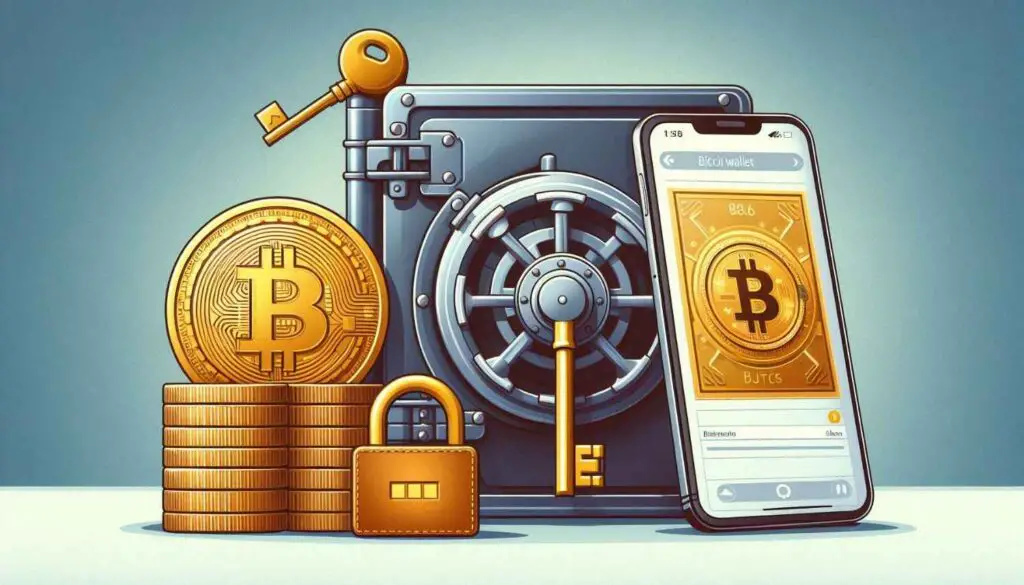Cryptocurrency is an exciting frontier that’s capturing the attention of investors worldwide, and the United States is no exception. If you’re a US investor looking Beginner-Friendly Crypto Wallets for US Investors. so one of the first things you’ll need is a reliable crypto wallet.
But with so many options out there, it can be overwhelming to figure out where to start.
Don’t worry—I’m here to guide you through everything you need to know about beginner-friendly crypto wallets.
By the end of this article, you’ll have a solid understanding of what a crypto wallet is, why you need one, and which wallets are best for someone just starting out.
Beginner-Friendly Crypto Wallets for US Investors

Introduction to Crypto Wallets
So, you’ve decided to dive into the world of cryptocurrencies—great choice! But before you can start buying, selling, or trading digital assets like Bitcoin or Ethereum, you’ll need a crypto wallet.
Think of it as your gateway to the crypto universe. But what exactly is a crypto wallet? Why is it so important?
And most importantly, which one should you choose if you’re just getting started? These are the questions we’ll explore in this comprehensive guide.
What is a Crypto Wallet?
Let’s start with the basics. A crypto wallet is a tool that allows you to interact with the blockchain—basically, it’s your interface with the crypto world.
Unlike a traditional wallet that holds physical cash, a crypto wallet doesn’t actually store your cryptocurrencies.
Instead, it holds the private keys you need to access your digital assets.
These private keys are like the passwords to your crypto—without them, you can’t access, send, or receive your coins.
This makes your wallet the most critical piece of your crypto toolkit.
If someone gets their hands on your private keys, they essentially have control over your crypto, which is why keeping these keys safe is paramount.
Importance of a Crypto Wallet for Investors
If you’re serious about investing in cryptocurrencies, having a secure crypto wallet is non-negotiable.
The crypto market is notorious for its volatility, and the last thing you want is to lose your assets due to poor security.
A good wallet not only keeps your assets safe but also gives you full control over them.
For US investors, this is particularly important given the regulatory environment surrounding cryptocurrencies.
Unlike traditional banking systems where your money is insured, cryptocurrencies are decentralized, meaning there’s no safety net if something goes wrong.
That’s why choosing the right wallet is crucial—it’s your first line of defense against hackers, scammers, and other potential threats.
Types of Crypto Wallets
Now that you understand what a crypto wallet is and why it’s essential, let’s dive into the different types of wallets available.
There’s no one-size-fits-all solution here—each type of wallet has its own pros and cons, and the best choice depends on your specific needs and experience level.
Hot Wallets vs. Cold Wallets
When we talk about crypto wallets, they generally fall into two categories: hot wallets and cold wallets.
Understanding the difference between these two types is key to making an informed decision.
Hot Wallets: The Essentials
Hot wallets are the go-to option for most beginners. These wallets are connected to the internet, making them incredibly convenient for everyday use.
If you’re planning to frequently buy, sell, or trade cryptocurrencies, a hot wallet might be the right choice for you.
The convenience of hot wallets comes from their accessibility—you can quickly and easily move your assets with just a few clicks.
This makes them ideal for those who are actively managing their portfolios or involved in day-to-day crypto transactions.
Mobile wallets like Coinbase Wallet or browser-based options like MetaMask are examples of hot wallets that are user-friendly and beginner-friendly.
However, the convenience of hot wallets comes with a trade-off in security.
Because they’re connected to the internet, hot wallets are more vulnerable to hacks.
This doesn’t mean they’re unsafe, but it does mean you need to be more vigilant about security measures like two-factor authentication (2FA) and strong, unique passwords.
Cold Wallets: The Essentials
On the other side of the spectrum, we have cold wallets. These wallets are not connected to the internet, making them much less vulnerable to online threats.
Cold wallets are considered the safest way to store your crypto, especially if you’re holding large amounts or don’t need frequent access to your assets.
Cold wallets come in various forms, but the most common are hardware wallets like the Ledger Nano S or Trezor.
These devices look like USB drives and store your private keys offline.
Because they’re not connected to the internet, they’re immune to hacking attempts—your crypto is safe unless someone physically steals your wallet and knows your access code.
The downside of cold wallets is that they can be less convenient for day-to-day use.
If you need to move your crypto quickly, it’s a bit more cumbersome than using a hot wallet. But if security is your top priority, especially for long-term storage, a cold wallet is the way to go.
Custodial vs. Non-Custodial Wallets
Another important distinction to understand is between custodial and non-custodial wallets. This refers to who holds the private keys to your wallet—yourself or a third party.

Custodial Wallets: Pros and Cons
A custodial wallet is one where a third party, usually a cryptocurrency exchange, holds your private keys for you.
This can be convenient, especially for beginners, because it takes the pressure off you to manage your keys.
If you lose your password, the exchange can help you recover access to your wallet.
However, the downside of custodial wallets is that you’re not in full control of your assets.
If the exchange gets hacked, goes bankrupt, or decides to freeze your account, you could lose access to your crypto.
This is why many seasoned crypto investors prefer non-custodial wallets, where they have complete control over their private keys.
Non-Custodial Wallets: Pros and Cons
Non-custodial wallets put you in the driver’s seat—you hold the private keys, which means you have full control over your assets.
This comes with increased responsibility, as losing your private keys means losing access to your crypto, with no way to recover it.
While this might sound intimidating, many non-custodial wallets are designed to be user-friendly and come with features that help you securely manage your keys.
Wallets like MetaMask and Trust Wallet are examples of non-custodial wallets that strike a balance between security and ease of use, making them accessible even to beginners.
Top Beginner-Friendly Crypto Wallets
Now that you have a solid understanding of the different types of crypto wallets, let’s take a look at some of the best options for beginners.
These wallets have been chosen for their ease of use, security features, and reputation in the industry.
Coinbase Wallet
Coinbase Wallet is a great starting point for anyone new to crypto. It’s linked to the Coinbase exchange, which is one of the most popular platforms for buying and selling cryptocurrencies in the US.
The wallet itself is user-friendly and supports a wide range of cryptocurrencies, from Bitcoin to lesser-known altcoins.
One of the biggest advantages of Coinbase Wallet is that it’s a non-custodial wallet, meaning you have full control of your private keys.
It also integrates seamlessly with the Coinbase exchange, making it easy to transfer assets between your wallet and the exchange.
Additionally, Coinbase Wallet offers robust security features, including two-factor authentication and biometric authentication for mobile users.
For beginners, the convenience and security of Coinbase Wallet make it an excellent choice. You get the best of both worlds—a user-friendly interface with the security of a non-custodial wallet.
MetaMask
If you’re interested in decentralized applications (dApps) or decentralized finance (DeFi), MetaMask is the wallet for you.
MetaMask is a browser-based wallet that integrates with popular web browsers like Chrome and Firefox.
It’s incredibly easy to set up and use, making it a favorite among beginners who are exploring the decentralized side of crypto.
MetaMask is a non-custodial wallet, so you’re in full control of your private keys.
It also supports a wide range of cryptocurrencies, primarily focusing on Ethereum and Ethereum-based tokens.
This makes it a great choice for anyone looking to get involved in the Ethereum ecosystem, whether it’s for trading tokens, participating in DeFi, or using dApps.
The interface is straightforward, and the wallet offers easy access to dApps directly from your browser.
For beginners looking to explore the more cutting-edge aspects of cryptocurrency, MetaMask is a top choice.
Exodus
Exodus is another excellent option for beginners, particularly those who prefer a desktop wallet.
Exodus is known for its sleek design and user-friendly interface, which makes it easy for anyone to navigate, regardless of their experience level.
One of the standout features of Exodus is its built-in exchange, which allows you to swap one cryptocurrency for another directly within the wallet.
This makes it incredibly convenient if you want to diversify your portfolio without using a separate exchange.
Exodus supports over 100 different cryptocurrencies, giving you plenty of options for your investments.
It’s also a non-custodial wallet, meaning your private keys are stored on your device, not on a third-party server.
This gives you full control over your assets, which is a big plus for security-conscious investors.
Another advantage of Exodus is its excellent customer support.
If you ever run into issues or have questions, Exodus offers 24/7 support, which is a big help for beginners who might need a little extra guidance.
Also Read – Which Type of Credit is Usually Used for Cars, Mortgages, and Student Loans?
Trust Wallet
Trust Wallet is a mobile wallet backed by Binance, one of the largest cryptocurrency exchanges in the world.
This association gives Trust Wallet a level of credibility and reliability that many other wallets don’t have.
It’s an excellent option for US investors who are looking for a secure and versatile mobile wallet.
Trust Wallet supports a vast range of cryptocurrencies—over 1,600 different assets.
Whether you’re holding Bitcoin, Ethereum, or some niche altcoin, Trust Wallet has you covered.
It also allows you to interact with decentralized applications (dApps) directly from your mobile device, making it a good choice for users who want to explore the world of decentralized finance (DeFi).
One of the standout features of Trust Wallet is its staking capabilities. If you’re holding certain cryptocurrencies like Tezos or Cosmos, you can stake them directly from your wallet and earn rewards.
This feature is especially appealing for investors who want to generate passive income from their crypto holdings.
Security-wise, Trust Wallet is non-custodial, meaning you control your private keys.
It also supports biometric authentication and a backup feature that ensures you can recover your wallet if you lose access to your device.
The interface is intuitive, making it easy for beginners to navigate and manage their crypto assets.
For US investors who want a powerful yet user-friendly mobile wallet, Trust Wallet is a top contender.
Its combination of broad asset support, staking capabilities, and strong security features make it an excellent choice for both beginners and more experienced users.
How to Choose the Right Wallet
With so many options available, you might be wondering how to choose the right crypto wallet for your needs.
The decision ultimately depends on a few key factors: security, ease of use, and the specific cryptocurrencies you plan to invest in. Let’s break these down to help you make an informed choice.
Security Features to Look For
Security should be your top priority when choosing a crypto wallet. After all, the primary purpose of a wallet is to keep your digital assets safe. Here are some essential security features to look for:
- Two-Factor Authentication (2FA): This adds an extra layer of protection by requiring two forms of identification before you can access your wallet.
- Encryption: Ensure that your wallet encrypts your private keys and other sensitive data to protect them from unauthorized access.
- Backup and Recovery Options: A good wallet will provide you with a recovery phrase (usually 12-24 words) that you can use to restore your wallet if you lose access. Make sure to store this phrase in a secure location.
- Biometric Authentication: Some wallets offer fingerprint or facial recognition as an additional security measure, particularly on mobile devices.
By choosing a wallet with these security features, you can significantly reduce the risk of losing your assets to hackers or other threats.
Ease of Use and Interface
If you’re new to cryptocurrencies, you’ll want a wallet that’s easy to navigate and understand.
A user-friendly interface can make a big difference in your overall experience, especially when you’re just starting out.
Wallets like Coinbase Wallet, Exodus, and Trust Wallet are known for their intuitive designs, making them ideal for beginners.
Look for a wallet that offers a simple setup process, clear instructions, and an easy-to-navigate interface.
Some wallets even offer educational resources or customer support to help you get up to speed quickly.
The easier the wallet is to use, the more confident you’ll feel managing your crypto assets.
Supported Cryptocurrencies
Not all wallets support every cryptocurrency. Before choosing a wallet, make sure it supports the specific coins or tokens you plan to invest in.
If you’re just starting out, you might be focusing on popular cryptocurrencies like Bitcoin or Ethereum, which are supported by almost all wallets.
However, if you’re interested in holding a more diverse portfolio that includes lesser-known altcoins, you’ll need a wallet that can accommodate them.
Wallets like Trust Wallet and Exodus offer broad support for a wide range of cryptocurrencies, making them versatile choices for investors who want to explore different assets.
On the other hand, if you’re only planning to invest in one or two major cryptocurrencies, a more specialized wallet might be sufficient.
Setting Up Your First Crypto Wallet
Ready to take the plunge and set up your first crypto wallet? Great! Here’s a simple step-by-step guide to get you started. Don’t worry—it’s easier than you might think.

Step-by-Step Guide
- Choose Your Wallet: Start by selecting one of the beginner-friendly wallets we discussed earlier. Consider factors like security, ease of use, and supported cryptocurrencies when making your choice.
- Download the App: For mobile wallets, download the app from the App Store or Google Play. For desktop wallets, visit the official website to download the software. Always make sure you’re downloading from a legitimate source to avoid phishing scams.
- Create an Account: Follow the prompts to create your account. This usually involves providing an email address and setting a strong, unique password. Some wallets may also require identity verification, especially if they’re linked to an exchange.
- Backup Your Recovery Phrase: This step is crucial. Most wallets will generate a recovery phrase—typically 12 to 24 random words. Write this phrase down on paper and store it in a safe place. Do not store it digitally where it could be hacked. If you lose access to your wallet, this recovery phrase is your only way to regain control of your crypto.
- Add Funds: Once your wallet is set up, you can add funds by transferring crypto from an exchange or another wallet. Most wallets provide a public address (a string of letters and numbers) where you can receive funds. Just copy this address and use it when transferring assets.
- Explore the Features: Take some time to explore the features of your wallet. Familiarize yourself with how to send, receive, and store crypto. If your wallet supports staking or dApps, consider experimenting with these features to see how they work.
Also Read – Charitable Financial Planning: A Comprehensive Guide
Common Mistakes to Avoid
As you set up and use your crypto wallet, here are some common mistakes to avoid:
- Not Backing Up Your Wallet: Never skip the backup step. Losing your recovery phrase means losing access to your crypto, with no way to recover it. This is a mistake you don’t want to make.
- Falling for Scams: The crypto world is full of phishing scams and other fraudulent activities. Always double-check URLs, don’t click on suspicious links, and never share your private keys or recovery phrase with anyone.
- Overlooking Security Features: Don’t ignore the security options available in your wallet. Set up two-factor authentication, use a strong password, and take advantage of any other security features your wallet offers.
- Using Untrusted Wallets: Only use wallets from reputable sources. Research a wallet’s reputation and read reviews before downloading. Untrusted wallets may have security vulnerabilities or could even be outright scams.
- Neglecting to Update Your Wallet: Developers regularly release updates to fix bugs and improve security. Make sure to keep your wallet software up to date to benefit from the latest features and protections.
Conclusion
Investing in cryptocurrencies can be a thrilling and rewarding experience, but it’s essential to start with the right tools.
A beginner-friendly crypto wallet is your gateway to the world of digital assets, helping you manage and secure your investments with confidence.
Whether you choose Coinbase Wallet, MetaMask, Exodus, or Trust Wallet, you’ll be well-equipped to navigate the crypto landscape.
Each of these wallets offers a unique blend of security, ease of use, and support for a wide range of cryptocurrencies.
As you gain more experience, you can explore other wallet options and features, but these beginner-friendly wallets will provide a solid foundation.
Remember, the key to successful crypto investing is to prioritize security, stay informed, and continually learn as you go.
The more you understand about how your wallet works and how to protect your assets, the more confident you’ll be in your crypto journey. So go ahead—choose your wallet, start exploring, and happy investing!
FAQs
1. What is the safest type of crypto wallet for beginners?
The safest type of crypto wallet for beginners is typically a cold wallet, such as a hardware wallet. These wallets are not connected to the internet, making them less vulnerable to hacks. However, they can be less convenient for frequent transactions. For beginners who prioritize security, a cold wallet is an excellent choice.
2. Can I use multiple crypto wallets at the same time?
Yes, you can use multiple crypto wallets at the same time. In fact, many investors choose to use different wallets for different purposes. For example, you might use a hot wallet for daily transactions and a cold wallet for long-term storage of your assets.
3. What happens if I lose my recovery phrase?
If you lose your recovery phrase, you will lose access to your crypto wallet and all the assets stored in it. There is no way to recover your wallet without the recovery phrase, which is why it’s crucial to store it in a secure location. Consider using a safe or another secure method to protect your recovery phrase.
4. Are crypto wallets free to use?
Many crypto wallets are free to use, particularly software wallets like Coinbase Wallet, MetaMask, and Trust Wallet. However, some hardware wallets, such as Ledger or Trezor, require a one-time purchase. Additionally, while using the wallet itself is free, you may incur transaction fees when sending or receiving crypto.
5. How do I transfer crypto from an exchange to my wallet?
To transfer crypto from an exchange to your wallet, you’ll need to copy the public address of your wallet and paste it into the withdrawal section of the exchange. Ensure that the address matches the correct cryptocurrency type (e.g., Bitcoin to a Bitcoin address). After confirming the transaction


2 thoughts on “Beginner-Friendly Crypto Wallets for US Investors”